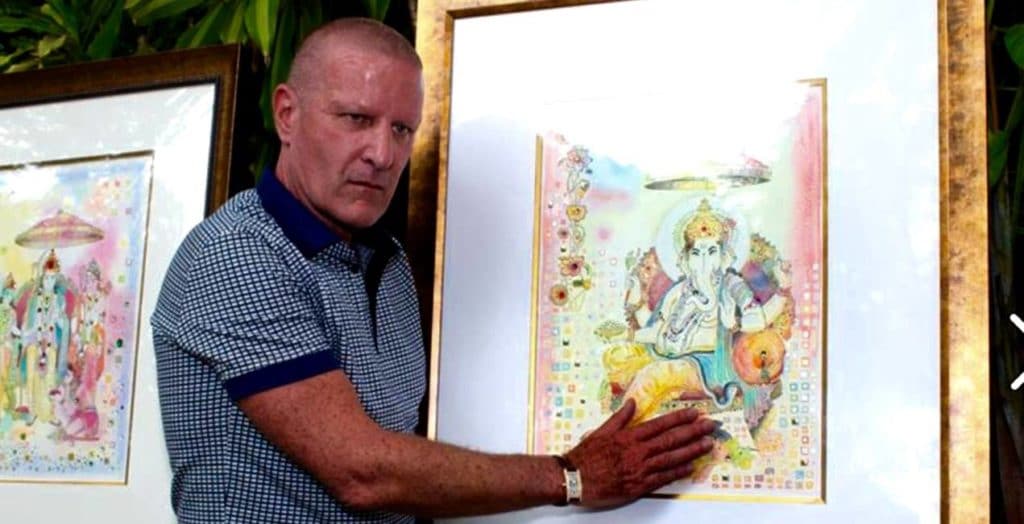“Your garbage is my gold,” says Olaf Van Cleef, a French artist who has given Indian calendar art a unique tangent by introducing a Parisian element to the classic Tanjore and Jaipur styles of painting. But what sets his creations apart is the glow that he adds to them — added by Swarovski crystals, and discarded wrapping paper.
The former counselor of high jewelry for Cartier, Van Cleef shuttles between Kolkata, Puducherry and Paris, and enjoys his stay in all the three cities. When in Puducherry, he can be spotted every Monday morning on the beach, collecting flashy wrapping papers of various shades, and even chocolate packaging. “I collect shiny papers from the beach and then use it in my paintings by pasting pieces of them along with multi-colored Swarovski crystals,” he tells Little India. “So, when someone looks at my paintings, the crystals sparkle. The glow that the Swarovski element adds to the paintings move along with the eye movement of the audience and that sets off a movement, that is unique to my creations.”
Bright hues like green, yellow and pink dominate his creations, and the Swarovski element adds the much-noticed grandiose to these paintings, lending them an eclectic charm that drives hundreds to see them. His recent three-day exhibition at Institute De Chandernagore during the famous Jagadhatri Puja at Chandannagar, a quaint town in West Bengal that was an erstwhile French colony, was thronged by many. Van Cleef’s deft fusion of the local flavor of the puja with his own style of painting lent the exhibition his trademark Indo-French appeal. The paintings aptly matched the local puja pandals, which were glittering with silver and gold adorned by the goddesses.
A painting of Lord Krishna by Olaf Van Cleef
“I tried to step out of my comfort zone and made a pandal where I showcased my paintings. It was the famous puja that drew me to it and I decided to go all out with colors,” he says.
While the 66-year-old artist paints most of his other creations in Paris, India is his preferred destination for his creations inspired from Indian and Buddhist gods and goddesses. “I want to be absolutely focused when I am painting and spend no less than 100 to 200 hours on each painting. Any work of art requires time and patience, it cannot be achieved overnight,” he explains.
His love for the jewelry adorned by religious figures in Indian mythology inspired him to paint them in his unique style. His mantra is quite simple. “I am a devotee of the beautiful jewelry that adorns the bodies of Indian deities. My art is only an expression of that love,” he says.
He made an interesting observation at the Chandannagar exhibition. Out of the 4,200 people who visited it, the youth of the town showed the most interest. “They loved the bright hues and vivid brush strokes and stopped to take selfies and pictures of the creations. It convinced me that the youth of today want to see more colors and it was quite encouraging,” he adds.
The Victorian charm of Kolkata draws Van Cleef to the city each year, and he remains enthralled by the old baroque-style buildings, the music, the cinema and the culture of the place. Kumartuli, the potters’ quarters set deep in the northern part of the city, is a place where he loves to spend time, since he learnt one of the facets of painting from them.
“The beauty of this old city lies in its people and its Victorian charm,” he stresses. “Many forget that it was the capital of the country during the British regime. The cranny nooks and corners of the city have a story to say and that is all you need when you are an artist.”
Olaf Van Cleef’s work inspired from Assam
Van Cleef’s love for India is also seen in his creations that portray nature. He is currently working on an exhibition centered on the theme of the flora and fauna of Assam, which will be showcased in Guwahati next year. “When I think of Assam, I think of butterflies, orchids, flowers, birds, the jungles and the fine rich silk of the state,” he says.
For now, he is set to exhibit his work at Dakshinachitra, a heritage museum located at Muttukadu near Chennai. The exhibition, scheduled to open on Dec. 23, will display a set of 52 paintings inspired by the deities of India. “The color palette ranges from flashy yellows and warm reds to the soothing hues of blues and greens,” he elaborates.
The latticed terraces and the bright French windows of Puducherry can be inviting for any French man and Van Cleef does not find it otherwise. His art gallery in the city is a platform for many a young artist who showcase their work at Van Cleef Hall. “Puducherry has a great mix of both France and India,” he says. “Living here is like living in a little France.”
